GERMANY
Society

Society
Cities in GERMANY
| Berlin | Cologne | Dortmund |
| Frankfurt | Hamburg | Heidelberg |
Popular destinations GERMANY
| Bavaria |
Society
State structure
The Constitution of 23 May 1949 declared the Federal Republic a “federal, democratic, parliamentary and social constitutional state”.
In Germany, the three powers in the central government are divided as follows:
- Legislative: the Bundestag and the Bundesrat
- executive: the Federal Government and the Chancellor
- in court: the Bundesverfassungsgericht and the judiciary in general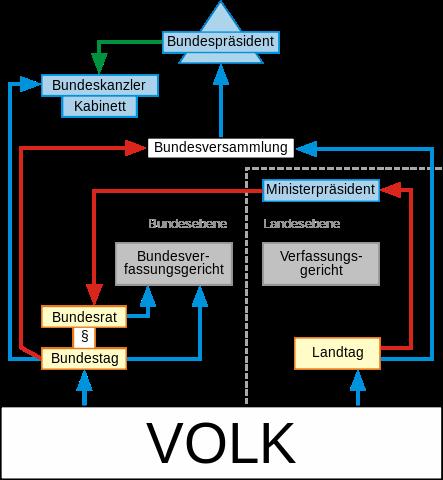 Overview political system in GermanyPhoto: Mortadelo2005, CC 3.0 Unported no changes made
Overview political system in GermanyPhoto: Mortadelo2005, CC 3.0 Unported no changes made
The Bundestag, the parliament, is the supreme body and exercises legislative power. The Bundestag is elected by the people for four years by universal direct suffrage, according to a system that is a compromise between proportional representation and the majority system. In certain cases it can be dissolved.
The main tasks are: legislation, controlling the government and electing the chancellor. The Bundestag currently has 672 delegates who moved from Bonn to Berlin in 1999.
The Federal Council consists of 69 members of the sixteen German state governments (three, four, five or six depending on the number of inhabitants of the respective state). The Federal Council has, among other things, a suspensive veto right against most of the laws passed by the Bundestag.
The Federal Council has a strong say in the drafting of laws that affect the federal states. The political balance of power in the Federal Council depends on the party composition of the state governments. It may be that the Bundesrat has a different majority than the Bundestag.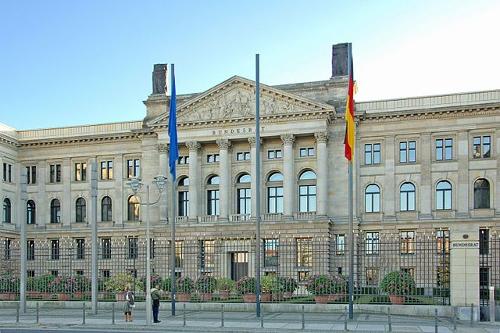 Building in Berlin that houses Germany's Federal CouncilPhoto: campsmum / Patrick Jayne and Thomas CC 2.0 Generic no changes made
Building in Berlin that houses Germany's Federal CouncilPhoto: campsmum / Patrick Jayne and Thomas CC 2.0 Generic no changes made
The Federal Government consists of the Chancellor (the President of the Government), and the Federal Ministers. The Chancellor is appointed by the Bundestag on the nomination of the Federal President; the federal ministers are appointed by the federal president on the recommendation of the chancellor. The Chancellor has great personal power because, for example, sets out the guidelines for government policy, which gives him great esteem within the cabinet.
Although all ministers are answerable to the Bundestag, only the Chancellor can be passed a so-called “constructive vote of no confidence”, as he is the only cabinet member elected by Parliament. He only has to resign if the majority agrees on the choice of a successor.
It has so far happened once in German post-war history that a chancellor was sent home by such a motion (Helmut Schmidt in 1982).
Overview Chancellors germany since 1949
| name | period | political party |
| Konrad Adenauer (1876-1967) | 1949-1963 | CDU |
| Ludwig Erhard (1897-1977) | 1963-1966 | CDU |
| Kurt Georg Kiesinger (1904-1988) | 1966-1969 | CDU |
| Willy Brandt (1913-1992) | 1969-1974 | SPD |
| Walter Scheel (1919-2016) | 1974 | FDP |
| Helmut Schmidt (1918-2015) | 1974-1982 | SPD |
| Helmut Kohl (1930-2017) | 1982-1998 | CDU |
| Gerhard Schröder (1944-) | 1998-2005 | SPD |
| Angela Merkel (1954- ) | 2005- | CDU |
The Federal President is the head of state but has very limited powers and is therefore mainly a representative function. The president signs new laws, after which they take effect. He is elected for five years by the Federal Assembly, a college consisting of the Bundestag and an equal number of deputies, elected by the parliaments of the federal states and can be re-elected once.
The Federal President is allowed to address sensitive issues in his own title.
Overview Federal Presidents of Germany since 1949
| name | period | political party |
| Theodor Heuss (1884-1963) | 1949-1959 | FDP |
| Heinrich Lübke (1894-1972) | 1959-1969 | CDU |
| Gustav Heinemann (1899-1976) | 1969-1974 | SPD |
| Walter Scheel (1919-2016) | 1974-1979 | FDP |
| Karl Carstens (1914-1992) | 1979-1984 | CDU |
| Richard von Weizsäcker (1920-2015) | 1984-1994 | CDU |
| Roman Herzog (1934-2017) | 1994-1999 | CDU |
| Johannes Rau (1931-2006) | 1999-2004 | SPD |
| Horst Köhler (1943- ) | 2004-2010 | CDU |
| Christian Wulff (1959- ) | 2010-2012 | CDU |
| Joachim Gauck (1940- ) | 2012-2017 | partyless |
| Frank-Walter Steinmeier (1956- ) | 2017- | SPD |
The supreme judicial power in Germany is the Constitutional Court or Bundesverfassungsgericht, and in summary it can be said that it watches over the constitution. It consists of two senates of eight judges each, half elected by the Bundesrat and the other half by an electoral commission of the Bundestag.
Both federal states and individuals who disagree on the interpretation of the constitution can ask the Bundesverfassungsgericht to pass judgment. Also, any German citizen can file a complaint with the court and the decision of the court is binding on all state organs, parties and persons.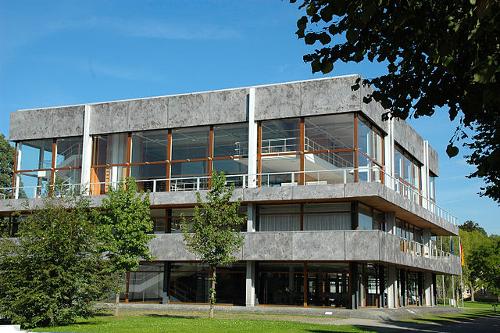 Building of the Bundesverfassungsgericht in Karlsruhe, GermanyPhoto: Guido Radig at German Wikipedia CC 3.0 Germany no changes made
Building of the Bundesverfassungsgericht in Karlsruhe, GermanyPhoto: Guido Radig at German Wikipedia CC 3.0 Germany no changes made
The federal states or Länder each have their own parliament, the Landtag. The Landtag elects a Prime Minister, who appoints the other members of the government. In Hamburg and Bremen, instead of the Landtag, they have the Bürgerschaft and instead of the government, the Senat.
The constitution delimits the powers of Bond and the states. Foreign affairs, nationality, finance, weights and measures, railways, air traffic, patent and copyright are reserved to the Federation, and furthermore, “Federal law breaks state law”.
For the current political situation, see chapter history.
Electoral system
The German electoral system is rather complicated. For example, the German voter can cast her or his vote twice. With the first vote or “Erststimme”, a voter chooses a candidate in his or her district according to the majority principle or “Mehrheits / Persönlichkeitswahl”. With the second vote or “Zweitstimme” you can vote on a party list according to the principle of proportional representation or “Verhältniswahl”.
The seats are allocated on the basis of the votes cast on the lists of parties or “Landeslisten” (Zweitstimme). These votes are used to calculate how many seats a party has received at national level, which are then divided per state.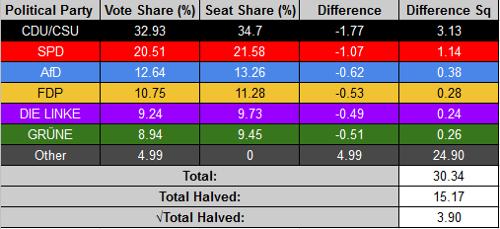 Results of national elections Germany 2017Photo: JDuggan101 CC 4.0 International no changes made
Results of national elections Germany 2017Photo: JDuggan101 CC 4.0 International no changes made
Only then the number of Erststimmen is looked at. The number of “direct mandates” is then deducted from the number of mandates to which a party in a federal state is entitled according to the second vote. The number of seats that remain is divided among the candidates who are highest on a Landesliste but have not obtained a Direct Mandat. In short, the second vote is decisive for the allocation of seats in the Bundestag.
Normally, a political party cannot join the Bundestag until it has obtained at least 5% of the vote. Even if a party receives the most votes in three or more constituencies, it can join the Bundestag. Such a party receives the status of “Gruppe” and then one does not have as many rights as of a directly elected faction. One limitation is, for example, that a “Gruppe” is not represented in all committees.
The Federal Republic is divided into 328 electoral districts or “Wahlkreise” and each voter may vote for a candidate within his or her electoral district (Erststimme). The candidate who wins the most votes within a district is directly elected in the Bundestag (Direktmandat).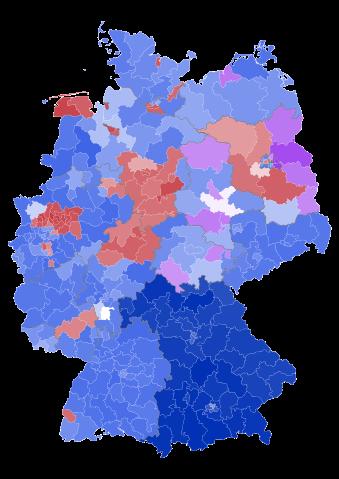 Wahlkreisen (electoral districts) GermanyPhoto: Wahlatlas CC 3.0 Unported no changes made
Wahlkreisen (electoral districts) GermanyPhoto: Wahlatlas CC 3.0 Unported no changes made
Administrative division
Germany is divided into 16 Länder, each with its own constitution and directly elected parliament and government. The federal states are independent tand are allowed to determine their own policy in the areas of education, nature conservation, water management and health care, provided that they are within the framework of the laws drawn up by the Federal Government.
The states have no influence on foreign policy, defense, railways and part of the taxes. The federal government and the governments of the federal states are jointly responsible in the areas of criminal law, immigration policy, housing and environmental legislation.
Conflicts between the federal states and the federal government are often resolved by the Bundesverfassungsgericht.
Overview federal states
| name | capital city | inhabitants | surface | |
| Baden-Württemberg | Stuttgart | 10.716.000 | 35.751 km² | |
| Bavaria | Munich | 12.692.000 | 70.553 km² | |
| Berlin | n / a. | 3.500.000 | 889 km² | |
| Brandenburg | Potsdam | 2.500.000 | 29.053 km² | |
| Bremen | n / a | 661.000 | 326 km² | |
| Hamburg | n / a | 1.774.000 | 755 km² | |
| Hesse | Wiesbaden | 6.094.000 | 21.114 km² | |
| Mecklenburg-Vorpommern | Schwerin | 1.600.000 | 23.170 km² | |
| Niedersachsen | Hannover | 7.860.000 | 47.343 km² | |
| North Rhine-Westphalia | Düsseldorf | 17.860.000 | 34.070 km² | |
| Rhineland-Palatinate | Mainz | 4.012.000 | 19.486 km² | |
| Saarland | Saarbrücken | 990.000 | 2.570 km² | |
| Sachsen | Dresden | 4.056.000 | 18.338 km² | |
| Sachsen-Anhalt | Magdeburg | 2.232.000 | 20.443 km² | |
| Schleswig-Holstein | Kiel | 2.831.000 | 15.731 km² | |
| Thuringia | Erfurt | 2.155.000 | 16.251 km² |
Brief description of all federal states of Germany:
Baden-Württemberg
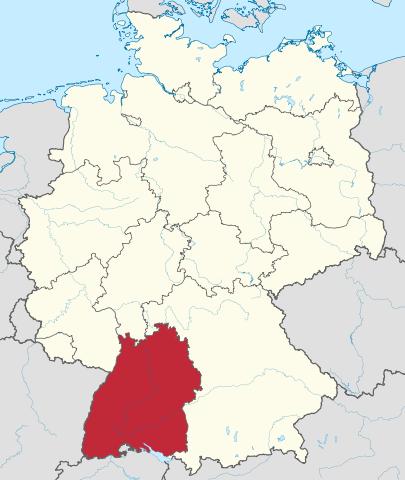 Location Baden-Württemberg in GermanyPhoto: TUBS CC 3.0 Unported no changes made
Location Baden-Württemberg in GermanyPhoto: TUBS CC 3.0 Unported no changes made
Baden-Württemberg is the third largest federal state in Germany and has the same surface area as Belgium and Luxembourg combined. The country is known as the most important high-tech area in Germany and even in Europe! Companies such as Mercedes Benz, Bosch, Porsche and Zeiss are all originally companies from this federal state. Furthermore, Baden-Württemberg is the land of spas and baths. The state receives millions of guests every year.
The main industries are electrical engineering, machine building and the automotive industry.
Young industries such as biotechnology, ICT, medicine technology and microtechnology are also becoming increasingly important in Baden-Württemberg. Biotechnology parks exist in Heidelberg, Freiburg, Ulm and Karlsruhe, among others, and around 2,200 software companies are located in the state. About a third of all goods and services produced in the state are destined for export. The export volume of Baden-Württemberg is larger than that of Spain, Switzerland or Sweden. Growth sectors are parts of services and the construction industry.
About 70 percent of the population lives in the urban areas and the largest cities are: Stuttgart, Mannheim, Karlsruhe and Freiburg.
Bavaria (Bayern)
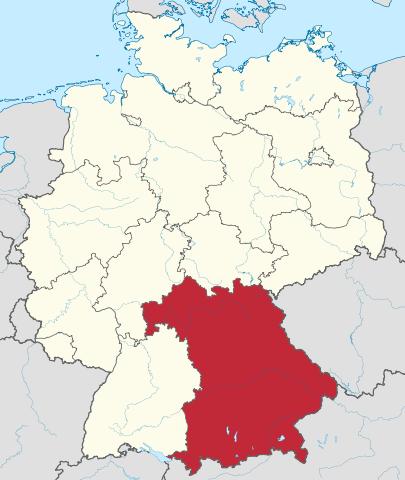 Location Bavaria in GermanyPhoto: TUBS CC 3.0 Unported no changes made
Location Bavaria in GermanyPhoto: TUBS CC 3.0 Unported no changes made
Bavaria is the largest federal state in Germany and has the same surface area as the Benelux or Ireland. The state was known as an economically backward area with a strong agricultural character, but has developed strongly since the Second World War into one of the most developed states in the field of industry and services. The share of agriculture in GDP is now only 1.3%.
More than 600,000 small and medium-sized enterprises (SMEs) are located in Bavaria. More than 77% of Bavarian employees work in SMEs. Business-oriented services in particular have developed positively in recent years. This sector shows a growth between 1996 and 1999 from 12,400 companies to a total of 127,000. It is mainly thanks to SMEs that the state of Bavaria has the lowest unemployment rate in the Federal Republic. In the last four years, SMEs have created 144,000 new jobs, which have compensated for job losses at large companies. Bavaria also has large multinationals in its territory such as Dasa-Aerospace, BMW, Adidas, Siemens and Audi. Bavaria also has many technological sectors such as information and communication technology, drug industry, biotechnology and space technology. In terms of service provision, Bavaria is the number one location and number two for banks in Germany. The Munich region has more than 10,000, mostly young, media companies (print media, audiovisual media, multimedia, advertising and information services).
The six main industries by turnover are:
1. Automotive industry
2. Mechanical engineering
3. Electrical engineering
4. Food industry
5. Chemical industry
6. Radio, TV and press technology
Berlin
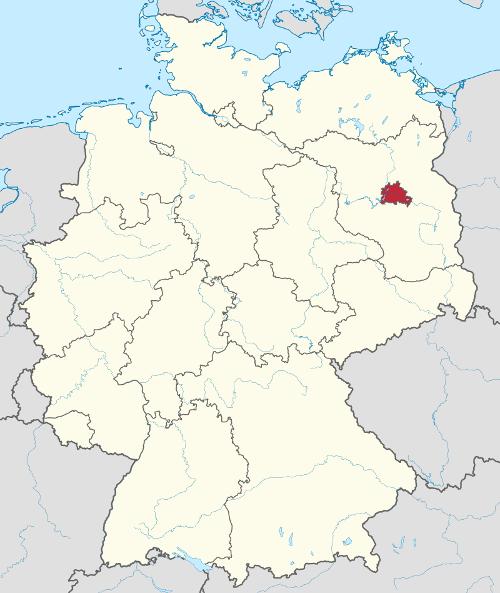 Location Berlin in GermanyPhoto: TUBS CC 3.0 Unported no changes made
Location Berlin in GermanyPhoto: TUBS CC 3.0 Unported no changes made
Berlin is the capital of Germany and is also considered one of the sixteen states. About as many people live in Berlin as in all of Ireland. The small federal state is located in the middle of the federal state of Brandenburg.
Services are the driving force behind Berlin's economy. Important core sectors in Berlin are traffic technology, biotechnology, media and communication, environmental technology and the pharmaceutical industry.
The media sector in Berlin is one of the most important in Germany. Berlin has 7,700 companies and about 70,000 employees active in the media and communications sector. In the city, 20 radio stations and 7 television broadcasters compete in Berlin to produce their programs. Berlin is also Germany's second publishing city. More local publications appear in Berlin than anywhere else in Europe. Among other things, 7 daily newspapers, 4 Sunday newspapers, 1 weekly newspaper and 11 city magazines will be published.
The industry in Berlin is characterized by small and medium-sized companies. Of the 2,200 companies, 94 percent employ fewer than 200 employees. The largest employers in Berlin are Deutsche Bahn AG, Siemens AG, Bankgesellschaft Berlin. Major production companies in Berlin are: BMW (motorcycles), Mercedes (car engines), Ford, DaimlerChrysler, Gilette, Philip Morris and Samsung. Some companies with a (European) head office in Berlin are: Siemens, Deutsche Bahn, Debis, IBM Deutschland and Coca-Cola. Medical and biotechnology are also important sectors with growth potential. Berlin is currently the most important biotechnology region with more than 120 companies.
Brandenburg
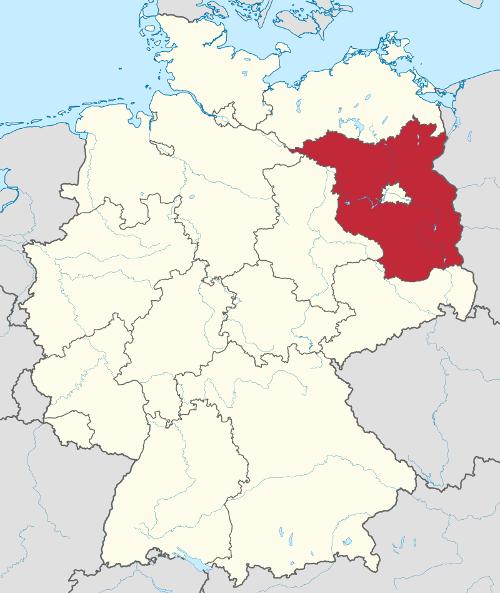 Location Brandenburg in GermanyPhoto: TUBS CC 3.0 Unported no changes made
Location Brandenburg in GermanyPhoto: TUBS CC 3.0 Unported no changes made
Brandenburg borders Poland and this makes the federal state interesting for entrepreneurs who are also interested in Eastern Europe as a market. In terms of area, the federal state is comparable to Belgium and the largest cities of Brandenburg are Potsdam, Cottbus and Brandenburg.
The Land, together with Mecklenburg-Vorpommern, remains the cause of concern for the Neue Bundesländer. Economic growth is lagging behind the other federal states and the unemployment rate is still high.
The level of education in Brandenburg is high because more than 80 percent of the population has an education and one in three people has a college or university degree.
Important industrial sectors are energy, chemicals, railway construction and wood processing, but new industries such as traffic technology (aerospace), biotechnology, media and communication and electrical engineering are also emerging strongly. The largest branch in Brandenburg is still the food industry, which accounts for a turnover of approximately 4 billion marks.
Furthermore, Brandenburg is the destination country number one of the new federal states with regard to tourism. There are approximately 7,000 catering companies that employ 45,000 people and generate a turnover of approximately 909 million euros.
Large companies located in Brandenburg include BMW / Rolls-Royce, Mercedes-Benz, ABB, Bosch-Siemens and BASF.
Bremen
 Location Bremen in GermanyPhoto: TUBS CC 3.0 Unported no changes made
Location Bremen in GermanyPhoto: TUBS CC 3.0 Unported no changes made
The smallest federal state in Germany is Bremen and consists of the city of Bremen and the port city of Bremerhaven. The area between Bremen and Bremerhaven (65 km) does not belong to the federal state of Bremen, but to the federal state of Lower Saxony.
More than 20,000 companies are located in Bremen. Transport, logistics, shipping and trade are the most important economic sectors for Bremen. But the automotive industry and the food industry (beer, fish, coffee, chocolate) are also well represented in Bremen. Some major producers are Beck & Co (Beck's Bier), Kellogg's, Kraft Jacobs Suchard and Nordsee.
Bremen is also referred to as the call center city of Germany. There are about 40 call centers in Bremen with a total of 2,000 employees.
Other important industries are: steel production, electrical engineering and aircraft construction.
Hamburg
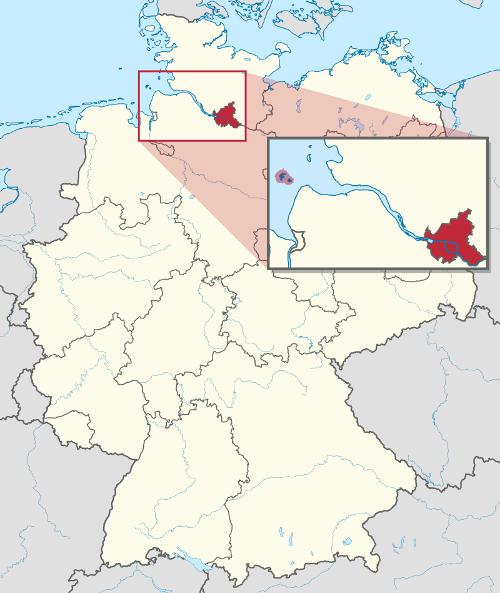 Location Hamburg in GermanyPhoto: TUBS CC 3.0 Unported no changes made
Location Hamburg in GermanyPhoto: TUBS CC 3.0 Unported no changes made
The city-state of Hamburg is, after Berlin, the city with the most inhabitants in Germany. Its 1.7 million inhabitants provide 4 percent of Germany's total gross domestic product. The city has one of the largest ports in the world and is centrally located between Scandinavia, Eastern and Western Europe.
Trade and services are important economic sectors in Hamburg, and about 75 percent of the workforce is employed in services. Insurance companies, banks, software developers, consultants, lawyers, trade associations and trading companies are particularly well represented in Hamburg. In addition, Hamburg, together with Toulouse in France, is a leader in the civil aviation industry in Europe. The important companies Airbus and Lufthansa Technik are located in Hamburg and the city has an international airport. Several publishing houses, television broadcasters, PR and advertising agencies and film companies have chosen Hamburg as their location.
Of the 500 most turnover companies in Germany, 41 are located in Hamburg and about 2,300 foreign companies are active in Hamburg.
Hesse
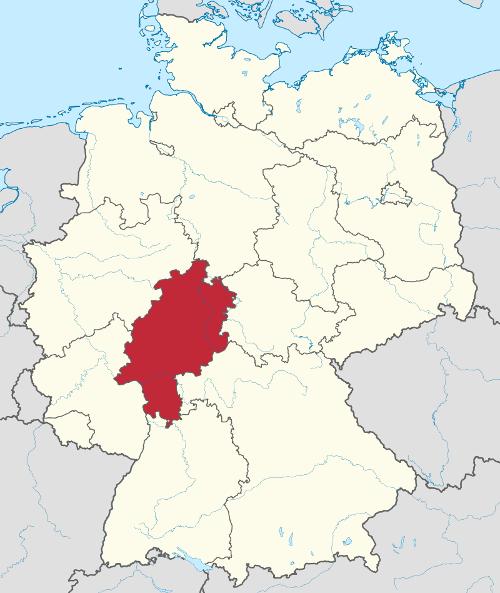 Location Hesse in GermanyPhoto: TUBS CC 3.0 Unported no changes made
Location Hesse in GermanyPhoto: TUBS CC 3.0 Unported no changes made
The Land of Hesse is the traffic and service center of Germany. The economic center of gravity is the Rhine-Main Region, with Frankfurt as the main city. Frankfurt am Main is the largest city in Hesse and one of the most important financial and trading places in Europe. More than 400 financial institutions are located there, more than two-thirds of which are foreign banks. Furthermore, Frankfurt has the largest station and the second most important airport (after London Heathrow) in Europe.
In addition to financial services and the transport sector, Hessen is also known as a stock exchange country. About 41 percent of all German trade fairs take place in Hesse Frankfurt. Hesse not only has service companies, but also the industry is represented in Hesse. The largest industrial sector is the chemical / pharmaceutical industry, the automotive industry, mechanical engineering, software companies and the plastics / rubber industry.
Some important companies in Hesse are: Opel, AEG, Deutsche Bank AG, Deutsche Bundesbahn, Mannesmann, Siemens, Linde, Hoechst, Lufthansa, FedEx, UPS, EMS and DHL.
The largest cities in Hesse are: Frankfurt am Main, Wiesbaden, Kassel, Darmstadt and Offenbach am Main.
Mecklenburg-Vorpommern
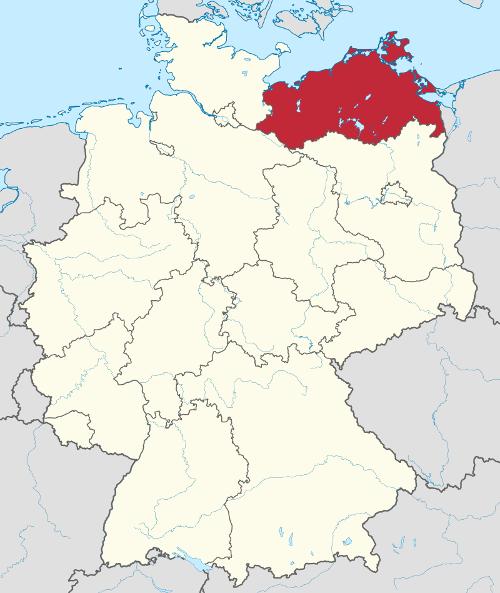 Location Mecklenburg-Vorpommern in GermanyPhoto: TUBS CC 3.0 Unported no changes made
Location Mecklenburg-Vorpommern in GermanyPhoto: TUBS CC 3.0 Unported no changes made
Mecklenburg-Vorpommern is the most north-eastern federal state in Germany and is centrally located between Hamburg, Berlin and Szczecin in Poland. Mecklenburg-Vorpommern is the most sparsely populated federal state in Germany and has a very high unemployment rate. The country is still under construction and investments by the government are still necessary.
The state has a maritime character. This is not only due to the coastline that has a length of 354 kilometers, but also because of the various inland lakes. Germany's largest lake, Müritz, is located in Mecklenburg-Vorpommern. Shipbuilding is therefore an important sector in Mecklenburg-Vorpommern.
In 2002 UNESCO placed the Hanseatic cities of Stralsund and Wismar on the list of World Heritage Sites. The cities are known as representatives of the so-called German "Brick Gothic".
Lower Saxony (Niedersachsen)
 Location Lower Saxony in GermanyPhoto: TUBS CC 3.0 Unported no changes made
Location Lower Saxony in GermanyPhoto: TUBS CC 3.0 Unported no changes made
Lower Saxony is the second largest federal state in Germany and is larger than, for example, the Netherlands, Belgium or Denmark. Most residents and industry can be found in the southern part of the state in the areas around Hanover, Braunschweig and Hildesheim.
More than 60% of the land is used for agricultural activities and yet Lower Saxony is no longer an agricultural state. This is because less than 4 percent of the working population works in agriculture. Most of the workers (39 percent) are active in services. About 30 percent of the labor force is employed in industry and 20 percent in the trade and transport sector.
Transport and logistics are important factors in Lower Saxony as important North-South and East-West connections run right through the state. Niedersachsen has an extensive and high-quality traffic infrastructure. Furthermore, the insurance sector, the automotive sector and high-value industries, such as the ICT sector and biotechnology, are also present in Lower Saxony.
Some large companies in Lower Saxony are Volkswagen, Continental, Polygram, AEG, IBM, Minolta, Toshiba and Solvay. Furthermore, TUI, Germany's largest tour operator, and of course Deutsche Messe AG are also located in Niedersachsen. A total of 243,000 companies are located in Niedersachsen.
North Rhine-Westphalia (Nordrhein-Westfalen)
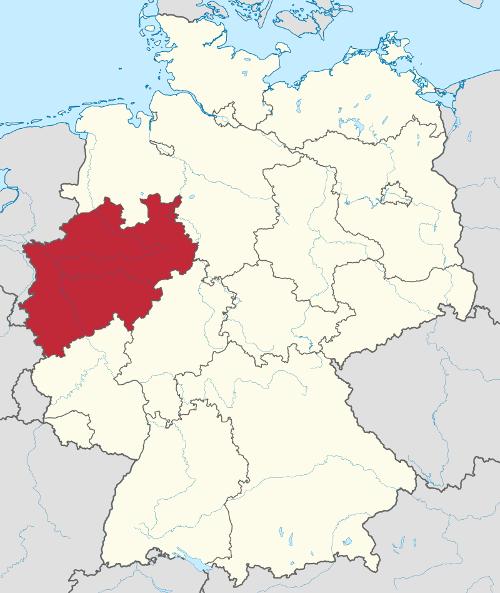 Location North Rine-Westphalia in GermanyPhoto: TUBS CC 3.0 Unported no changes made
Location North Rine-Westphalia in GermanyPhoto: TUBS CC 3.0 Unported no changes made
North Rhine-Westphalia is the most important federal state in Germany. This is where most of the inhabitants live and about 22 percent of the gross domestic product is generated here. North Rhine-Westphalia is the same size as Belgium and Luxembourg combined and has more inhabitants than the whole of the Netherlands. This is also an important federal state for the Netherlands. More than 30% of the total Dutch exports to Germany goes to this German state.
Almost all industries are represented here and important sectors are technology and the service sector. The main sub-sectors are chemicals, mechanical engineering, steel industry, food industry, metal processing / automotive industry, electronics, and the paper, publishing and printing industries. 20 of Germany's 40 largest companies are located in NRW, including VEBA, Deutsche Telekom, RWE, Bayer, Thyssen, Mannesmann, Ford, Krupp-Hoesch, Bertelsmann and Henkel.
Rhineland-Palatinate (Rheinland-Pfalz)
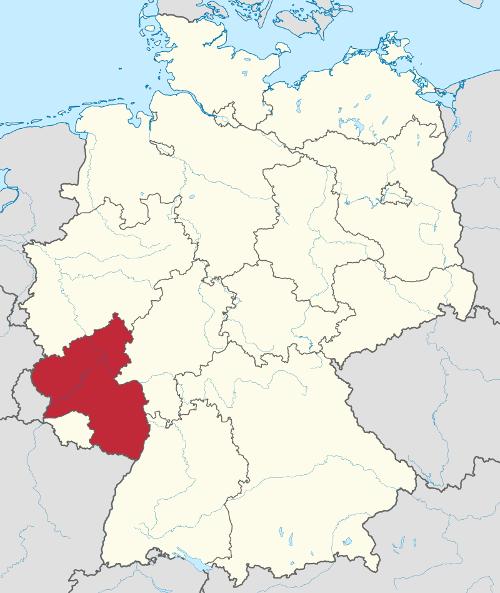 Location Rhineland Palatinate In GermanyPhoto: TUBS CC 3.0 Unported no changes made
Location Rhineland Palatinate In GermanyPhoto: TUBS CC 3.0 Unported no changes made
Rhineland-Palatinate has a beautiful and varied landscape through which the Rhine and Moselle make their way. Rhineland-Palatinate is Germany's largest wine-growing country.
The largest chemical concern in Europe, BASF, is based in Rhineland-Palatinate. BASF is the largest employer in the Rhineland with 44,850 employees. Rhineland is also the location of the glass factory Schott, Mercedes, Boehringer, Opel, IBM and the RTV channels ZDF, SAT1, 3sat and SWR.
The chemical industry is the most important industry in Rhineland-Palatinate with a turnover of more than 30 billion marks. Furthermore, mechanical engineering and the car industry are also engines behind the country's economy. Other major industries are the plastics industry, glass industry, metal processing and the paper and printing industry.
In 2002, UNESCO placed the 65-kilometer-long Middle Rhine Valley between the cities of Bingen and Koblenz on the list of World Heritage Sites. In the Rhine Valley lies, among other things, the rock on which, according to legend, the seductive skippers passing by Loreley plunged to destruction with her song.
Saarland
 Location Saarland in GermanyPhoto: TUBS CC 3.0 Unported no changes made
Location Saarland in GermanyPhoto: TUBS CC 3.0 Unported no changes made
Saarland is a small federal state of Germany. Services are an important driver of the Saarland economy, including tourism, software development, telecommunications and consultancy. Tourism, in particular, has risen sharply in recent times. The number of overnight stays in Saarland has doubled since 1986 and approximately 20,000 people work in this sector.
The largest growth sectors in the industry are mechanical engineering, the automotive industry, the plastics processing industry and the metal processing industry. Two large companies in Saarland are Ford and Villeroy & Boch.
Saxony (Sachsen)
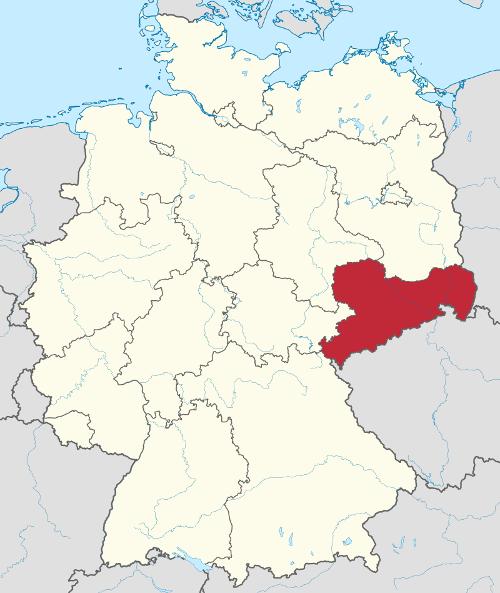 Location Saxony in GermanyPhoto: TUBS CC 3.0 Unported no changes made
Location Saxony in GermanyPhoto: TUBS CC 3.0 Unported no changes made
Saxony borders the Czech Republic, Poland and a few other German states. Thanks to this favorable geographic location, Sachsen fulfills an important bridging function between Eastern and Western Europe. In terms of inhabitants, the country is the same size as Denmark, making it the largest East German state. The state has a young population with an average age of 35 years. The average is therefore one year lower than in the other new federal states and three years lower than in the old federal states.
Saxony is doing relatively best of all East German states. It is true that economic growth is certainly not overwhelming; the export ratio, on the other hand, is steadily increasing. The state is very popular with new investors because of good location factors such as an excellent communication network and infrastructure, well-trained staff, good investment schemes and proximity to colleges and universities.
Unemployment is quite high, as in the other East German states. Almost all industries are represented in Saxony. An important industry in Saxony is micro-electronics and other traditional industries such as the textile industry, machine building and the car industry. Some large companies in Saxony are Audi, Melitta, Stabag, Wella and the Dresdner Bank.
Saxony-Anhalt (Sachsen-Anhalt)
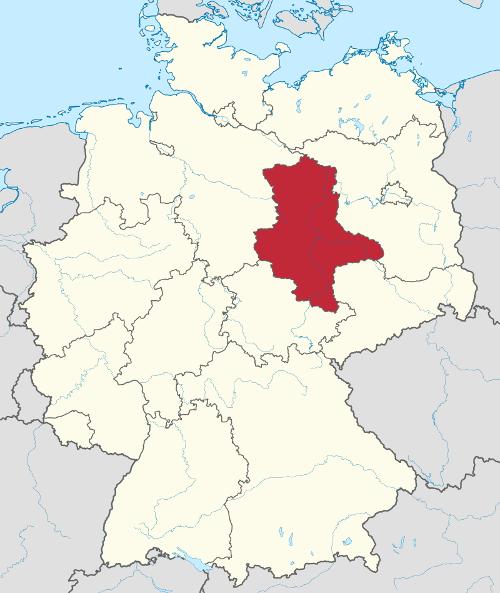 Locartion Saxony-Anhalt in GermanyPhoto: TUBS CC 3.0 Unported no changes made
Locartion Saxony-Anhalt in GermanyPhoto: TUBS CC 3.0 Unported no changes made
Saxony-Anhalt is about the same size as Hesse and about 25% of the population lives in the cities of Halle, Magdeburg and Dessau. The most northern wine regions of Germany are located around Saale and Unstrut.
Chemistry, machine building and the food industry are the most important industries. Coca Cola, Nestlé, Erasco, Elf, Akzo Nobel, Dow Chemical and Bayer have invested heavily in this region.
Schleswig-Holstein
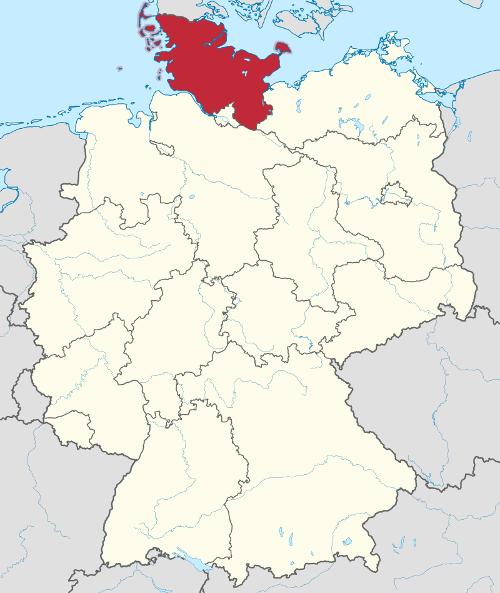 Location Schleswig-Holstein in GermanyPhoto: TUBS CC 3.0 Unported no changes made
Location Schleswig-Holstein in GermanyPhoto: TUBS CC 3.0 Unported no changes made
Schleswig-Holstein is the northernmost federal state in Germany and borders, among others, Denmark and the North and Baltic Sea. Schleswig-Holstein connects Scandinavia with Western Europe and the state is therefore a distribution link between these two areas. The channel between the North and Baltic Sea is one of the busiest (constructed) canals in the world.
Hamburg is close to Schleswig-Holstein and the state benefits considerably from it. Many industries are located near Hamburg, but just in the territory of Schleswig-Holstein. In total, there are approximately 100,000 companies located in the state.
Important sectors in Schleswig-Holstein are mechanical engineering (Krupp Maschinebau), the food industry, measurement and control technology, the chemical industry and the publishing industry (Axel Springer Verlag). Since the state has traditionally been very strong in the agricultural sector, the food industry has been able to develop very well here.
Thuringia
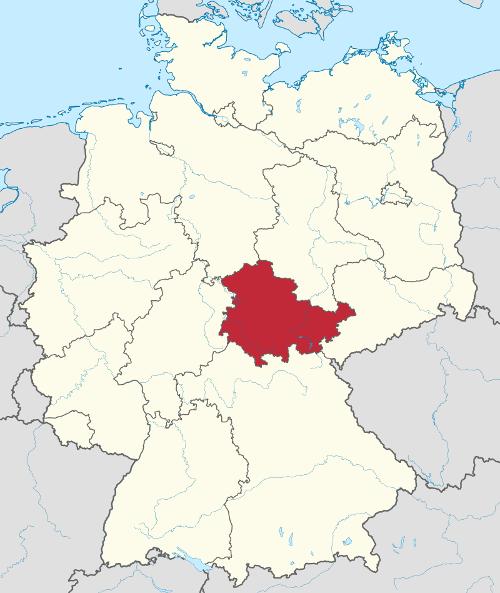 Location Thuringia in GermanyPhoto: TUBS CC 3.0 Unported no changes made
Location Thuringia in GermanyPhoto: TUBS CC 3.0 Unported no changes made
Thuringia is centrally located in Germany and the main cities are the capital Erfurt and the cities Gera, Jena and Weimar. Together with neighboring Saxony, Thuringia is the most industrialized of the Neue Bundesländer.
Industry is the main driver of economic growth in the state and is very strongly dominated by small and medium-sized enterprises.
Electrical engineering, optical industry, precision mechanics, mechanical engineering and the automotive industry are the industries that characterize Thuringia, in addition to trade and logistics. Ikea, for example, has its distribution center in Saxony and Otto and METRO are also located in Thuringia. Other industries present in Thuringia: food industry, metal industry and glass and ceramic industry.
Erfurt is, in addition to the state center of government, a location for microelectronics, machine building and the furniture industry.
The optical industry, fine mechanics and medical technology are located near Jena, among others. Jena, like many other German cities, tries to profile itself as a high-tech location for starting entrepreneurs. One of the best-known starters is Intershop. This company was founded in 1994 and has grown in 6 years to become one of the foremost software specialists in the field of e-commerce. The company now has more than 500 employees and is listed on the stock exchange.
The automotive industry is mainly concentrated in Eisenach. Here Opel produces, for example, the Corsa and Astra. Bosch is active in Eisenach in the field of sensors for the automotive industry.
Schwarza / Rudolstadt is home to the largest synthetic fiber industry in East Germany and Saalfeld is the center of the Thuringian steel industry.
Some other companies based in Thuringia: BMW, Fujitsu, IBM, AlliedSignal, Lear Corporation.
Education
Nursery and primary education
Pre-primary education includes Kindergarten and so-called preparation classes. Kindergarten is the traditional voluntary form of pre-primary education for children from 3 to 6 years old. The also voluntary preparation classes or “vorklassen” are attached to a primary school, and are intended for children of 5 years old who are not yet required to attend school, but whose parents want them to receive special guidance and preparation for primary school.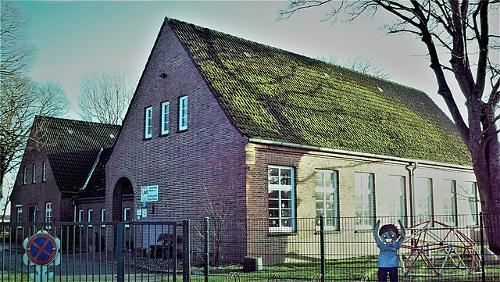 Kindergarten in Berumbur-Kleinheide (Lower Saxony)Photo: GregorHelms CC 4.0 International no changes made
Kindergarten in Berumbur-Kleinheide (Lower Saxony)Photo: GregorHelms CC 4.0 International no changes made
From the age of six all German children are of compulsory school age. Compulsory education usually lasts 12 years, of which nine years are full-time education and three years are partially compulsory. In some states, children must attend full-time school for ten years. In most states, pupils can voluntarily attend a tenth year of school to obtain a diploma that gives them access to secondary education.
Compulsory education includes primary school (Grundschule) for children from 6 to 10 years old and the first phase of secondary education for 10 to 15 year olds. After primary school, various directions can be chosen in secondary education:
Hauptschule: general education from the fifth to the ninth grade.
Realschule: general education of a higher level from the fifth to the tenth grade. With their diploma, students can proceed to vocational training and to school types that are completed with a VWO diploma.
Gymnasium: highest level of secondary education and usually goes from fifth to thirteenth grade. The “Abitur” gives access to the university.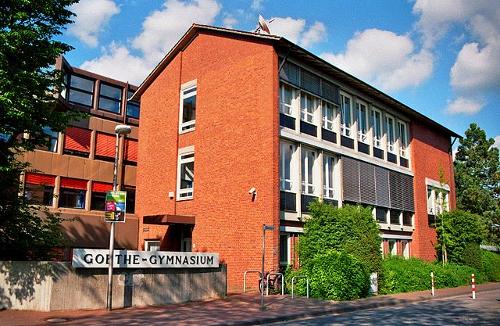 Städtisches Goethe-Gymnasium in Ibbenbüren, North Rhine-Westphalia, GermanyPhoto: J.-H. Janßen CC 3.0 Unported no changes made
Städtisches Goethe-Gymnasium in Ibbenbüren, North Rhine-Westphalia, GermanyPhoto: J.-H. Janßen CC 3.0 Unported no changes made
Gesamtschule (Middle Schools): same subjects as in the above school types, but the Gesamtschulen curriculum also includes all subjects taught in other school types. In the fifth and sixth grade, all students are taught together. The final diplomas are awarded under the same conditions as for the traditional school types.
In recent years, new types of schools have been introduced in a number of federal states, combining the curricula of the Hauptschule and the Realschule.
Secondary education
Higher secondary education is optional. The second phase of secondary for the age group of 16 to 19 offers students the following options:
General education: general education is provided in the highest classes of the “Gymnasium”, usually from the 11th to the 13th grade.
Vocational education based on full-time education is provided at the following schools: Berufsaufbauschulen, Fachoberschulen, beruflichen Gymnasien / Fachgymnasien and Fachschulen. There are also combinations of general education and vocational education.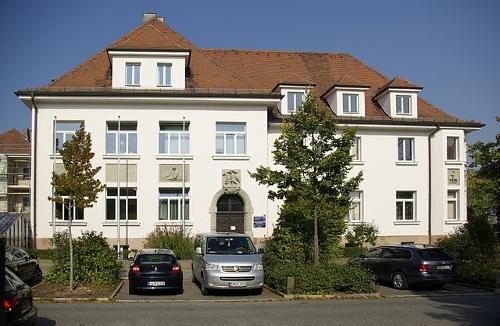 Staatliche Fachschule für Agrarwirtschaft in Fürth (Bavaria), GermanyPhoto: Janericloebe CC 3.0 Unported no changes made
Staatliche Fachschule für Agrarwirtschaft in Fürth (Bavaria), GermanyPhoto: Janericloebe CC 3.0 Unported no changes made
School performance is assessed with grades between 1(lowest) and 6(highest).
Higher education
Higher education in Germany can be university or non-university. Higher education includes:
Universities and integrated universities: there are various disciplines at universities and students can obtain a PhD. Integrated universities are a combination of universities, higher professional education and in part music and art academies.
The oldest university in Germany is the Ruprecht-Karls-University in Heidelberg (Baden-Württemberg), this city was granted the right to open a university by Pope Urban VI on October 23, 1385, the third in the Holy Roman Empire after Vienna and Prague.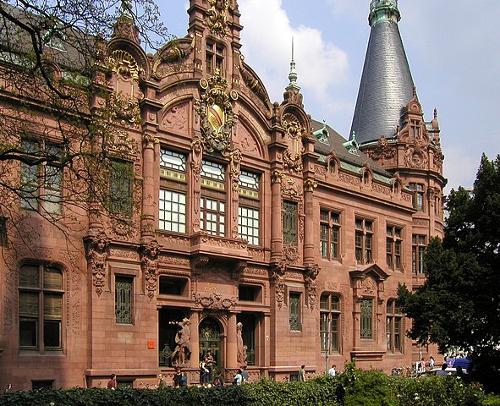 Ruprecht-Karl-University in Heidelberg, GermanyPhoto: Jan Beckendorf CC 2.0 Generic no changes made
Ruprecht-Karl-University in Heidelberg, GermanyPhoto: Jan Beckendorf CC 2.0 Generic no changes made
Academic and specialized higher education institutions are combined in the Gesamthochschulen.
Higher professional education mainly offers practical training courses for engineers in economics, agriculture, the social sector, library and documentation studies and computer science.
Pedagogical academies train primary school teachers and teachers for certain school types of the first stage of secondary education; all other teachers are trained at the university. The university in Germany with the most students is the FernUniversität in Hagen (North Rhine-Westphalia), specialized in distance learning, with approx. 77,000 students. FernUniversität Hagen is the university with the most students in GermanyPhoto: FernUniversität in Hagen CC 3.0 Unported no changes made
FernUniversität Hagen is the university with the most students in GermanyPhoto: FernUniversität in Hagen CC 3.0 Unported no changes made
The studies are usually divided into a “Grundstudium”, which is concluded with an intermediate exam, and a “Hauptstadium”, which is concluded with an academic degree.
Furthermore, so-called “Hochschulprüfungen” can be taken, which includes the following exams:
The “Diplomführung” with which the title of PhD student is obtained.
The “Magisterprüfung” that conferred the title of master.
The promotion that entitles the holder to the title of doctor.
Some studies are concluded with the “Staatsprüfung”. They are medicine, dentistry, veterinary medicine, pharmacy, law and the academic teacher training.
Sources
Ayer, E.H. / Germany
Lucent Books
Egert-Romanowska, J. / Duitsland
Van Reemst
Europese Unie : vijftien landendocumentaties
Europees Platform voor het Nederlandse Onderwijs
Mark, D.F.W. van der / De Bondsrepubliek Duitsland voor en na 1990 : geschiedenis, politiek, economie en ruimtelijke ontwikkeling
Landensurveys
Tatsachen über Deutschland
CIA - World Factbook
BBC - Country Profiles
Copyright: Team The World of Info